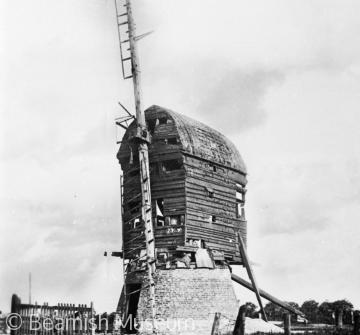Industry before the Industrial Revolution
 The 'stob mill' at Grangetown south of Ryhope, Sunderland (since demolished) is one of the simplest and earliest forms of windmill.
The 'stob mill' at Grangetown south of Ryhope, Sunderland (since demolished) is one of the simplest and earliest forms of windmill.Although clothmaking dominates our view of medieval English industry, among the most important industries were milling, tanning and ironworking.
The watermill was an ancient device for grinding corn but in the Middle Ages it was adapted for use in the cloth and metal industries and some corn mills were converted or extended as fulling or tucking mills and blade mills. However, not every community had access to suitable waterpower and animal-powered mills for grinding were not very efficient. European windmills appear to have been invented in the 12th century and became very popular. Large numbers were built in England in the 13th and 14th centuries. Some remain in use but most have been converted or demolished. They were important in inland counties like Derbyshire and also around large towns like Sunderland to supply local bakeries. Like watermills they could be adapted for other uses and many were employed in the Fens in the 17th century for draining. Small windmills were used to raise well water. Grist and flour milling with stones was universal until well after the Industrial Revolution. Early grindstones were made locally and the resulting bread was often inimical to human teeth but the introduction first of Derbyshire millstones and later of French burrstones improved milling. Mills employed the skills not only of millers but also of millwrights who were often at the forefront of mechanical invention. As mills were the earliest and most common users of non-human power the word mill came to be used for any building containing powered machinery.
Tanning was practiced wherever there were plentiful animal skins and a water supply. It was an antisocial industry usually driven to the eastern outskirts of towns and villages and often accused of polluting local water supplies. Early tanneries might be find surprisingly near the centre of market towns like Ledbury, Herefordshire and Burford, Oxfordshire although the actual tanning was probably done in pits elsewhere and only dressed in town. Burford has a street called Leather Alley and many towns and villages have Tanyard, Tannery or Tanner street names. Leather was an important product needed by shoemakers and cordwainers, glovers, girdlers, saddlers, harness makers, bookbinders, tailors who made leather breeches and corsets from the 16th century, bottlemakers, and upholsterers. A related industry important in a pre-industrial age was parchment making for books and documents.
The refining of lead and iron was often done near the mines especially in remote areas like Exmoor in Somerset, the Derbyshire and Yorkshire Pennines but iron bloomeries were also found in the Kentish Weald and parts of Cheshire and Herefordshire. Most communities had at least one blacksmith to make and repair tools, ploughshares, and fire irons. Horseshoes were the mainstay of many country smiths but large industrial forges produced cannon and armour. Although most smiths might be regarded as craftsmen bellfounding in the Middle Ages was more of an industry. Although there were itinerant bellfounders bells were also cast at foundries in towns like Bristol. By the early 18th century copper and brass foundries had been established at Warrington, Cheshire and in villages around Bristol and Bath. Montacute in Somerset made cauldrons and skillets for the kitchen on an industrial scale.
Other early industries included papermaking, carpentry, glassmaking as at Sunderland, pottery and porcelain production, and tobacco pipe making as at Bolsover in Derbyshire. Some early local industries survived the industrial revolution such as pottery making in Staffordshire, papermaking at Snodland, Kent and bellfounding in Whitechapel but others declined in the face of competition.










